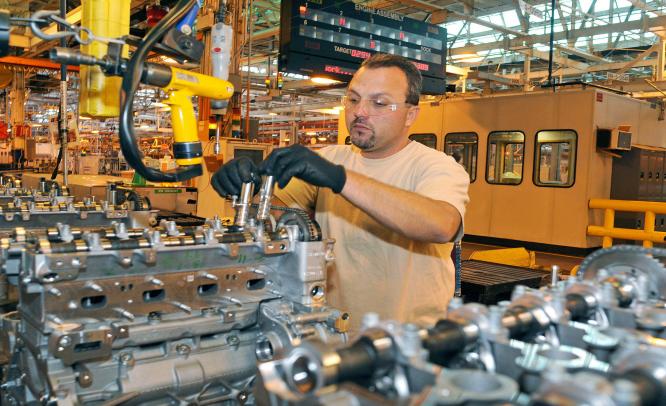Industrial production highest in six months as motor vehicles and parts emerge as biggest gainers, reports Team IFM
New York, March 18: American manufacturers and allied industrial sectors seem to have shrugged off the winter drag to ramp up production in February to mark the highest increase in the past six months and offset the decline registered in January, official data released on Monday showed.
Federal Reserve statistics – which covers output, capacity, and capacity utilisation in the US industrial sector and comprises manufacturing, mining, and electric and gas utilities – shows industrial output led by the auto sector rose 0.6 percent in February after having declined 0.2 percent in January.
The capacity utilisation rate for total industry increased to 78.8 percent, a rate that is 1.3 percentage points below its long-run (1972–2013) average, Fed Reserve said in a statement. Utilisation is a measure of the “slackness” at factories and reflects the growth potential of an economy.
The Federal Reserve’s data compares with the predictions of financial information services provider Dow Jones, which said economists it surveyed had forecast output to rise 0.1 percent in the month under review, while the utilisation rate would be around 78.5 percent. Those polled by news wire agency Reuters had expected manufacturing output to rise 0.2 percent and industrial production to edge up 0.1 percent.
The Federal Reserve Board plans to issue its annual revision to the index of industrial production (IP) and the related measures of capacity utilisation on March 28.
American manufacturing activity slowed considerably in January mainly on account of severe cold weather conditions, a slowdown in securing fresh orders and inventories, even as the consumer confidence index of The Conference Board, a New York-based economy tracker, showed consumers’ expectations kept climbing in January.
“Many companies blaming exceptionally cold weather for production and supply chain disruptions (in January), the underlying trend looks to have remained robust,” said Chris Williamson, Chief Economist at economy tracker Markit.
“The improvement supports the view that the economy is withstanding the ongoing tapering by the Fed,” Williamson added. “However, it will be important to see the indices bounce back from January’s weather-related weakness to be sure of this resilience.”
February Rebound
Apparently, the rebound that Williamson talked of did take place during the month under review. In February, manufacturing output rose 0.8 percent and nearly reversed its decline of 0.9 percent in January, “which resulted, in part, from extreme weather”, Fed Reserve said.
“The gain in factory production in February was the largest since last August,” it further noted. “Much of the swing in the rates of change for production in January and February reflected the depressing effects on output of the severe weather in January and the subsequent return to more normal levels of production in February.”
The level of factory output in February was 1.5 percent above its year-ago level. Capacity utilisation for manufacturing moved up 0.5 percentage points in February to 76.4 percent, a rate 2.3 percentage points below its long-run average, Fed Reserve said.
The production of durable goods rose 0.9 percent in February and was 2.7 percent above the figure a year earlier, and “large increases” in February for several categories of durables more than offset large decreases in other categories, it said.
“The biggest gain was in the output of motor vehicles and parts, which advanced 4.8 percent,” the Fed Reserve statement said, with the indexes for machinery and fabricated metal products each moving up around 1.5 percent.
Capacity utilisation for durable goods manufacturing rose 0.5 percentage point to 76.6 percent, a rate 0.4 percentage point below its long-run average.
The output of power utilities edged down 0.2 percent following a jump of 3.8 percent in January, and the production at mines moved up 0.3 percent.
At 101.6 percent of its 2007 average, total industrial production in February was 2.8 percent above its level of a year earlier, the data showed.
January Blues
Industrial production data for February should enthuse markets as manufacturing activity had slowed considerably in January on account of a severe winter and a dearth of new orders and inventories.
The Institute for Supply Management Manufacturing Business Survey, based on feedback from the nation’s supply executives, said in a report on February 4 that though the sector expanded for the eighth consecutive month, it was the slowest since May 2013.
Another second set of data, the Markit US Manufacturing PMI, reflected a similar situation. “The slowdown also reflected in part a drop in new export orders for the first time since last September,” Markit said in a statement.
Of the 18 manufacturing industries that ISM surveyed, 11 that reported growth in January were primarily intermediate goods producers in sectors such as plastics and rubber products, primary metals and textile mills.
Of the seven industries reporting contraction were consumer goods producers in sectors like non-metallic mineral products (such as cement and glass); petroleum and coal products, and apparel and leather products.
“A number of comments from the panel cite adverse weather conditions as a factor negatively impacting their businesses in January, while others reflect optimism and increasing volumes in the early stages of 2014,” said Bradley Holcomb, chair of the ISM’s Business Survey Committee.
The latest Federal Reserve data shows there was indeed reason for this optimism.


